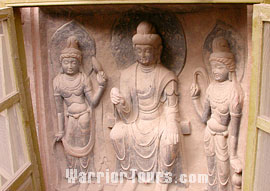- Mogao Caves & White Horse Dagoba
- Bingling Thousand Buddha Caves
Bingling Thousand Buddha Caves

Located in the Jishi Hills 35 kilometers (22 miles) southwest of Yongjing County, Gansu Province, Bingling Thousand Buddha Caves are cultural treasures of the Silk Road. Here lies one of the four most well-known stone caves in China, just second to the Mogao caves in artistic value. Bingling translated from Tibetan language means 'ten thousand Buddhas'.
The construction of the caves and Buddhas began as early as the Western Qin Dynasty. At that time, the local rulers of Xianbei Nationality believed in Buddhism, so cave building and statue sculpting were rather active. Cave No. 169 is representative of this era with, statues combining the craftsmen's life experience, appreciation of beauty, vivid expressions, elegant poses any fluent clothes.
Later, Bingling Thousand Buddha Caves were expanded and renovated in the Northern Wei, Northern Zhou, Sui, Tang, Song, Western Xia, Yuan, and Ming Dynasties. During the Tang Dynasty, the popularity of statue sculpting rose again due to the prosperity of Buddhism. Famous niches constructed during this period were caves No. 46, No. 50, and No. 51. Most of the statues in the caves of the Tang Dynasty are assembled with one Buddha, two or four Bodhisattvas and two Heaven Kings, while a few have one Buddha, two Arhats, two Bodhisattvas and two Heaven Kings. During the Tang Dynasty health and plumpness were favored resulting in these characteristics being reflected in the statues. Unique features of these rugged and powerful carvings include the use of long faces, exaggerated poses, along with a lack of edges and corners.
During the Yuan and Ming Dynasties, construction of the caves and statues began to decline, although there were still some repairs and renovations. After the establishment of the People's Republic of China, Bingling Thousand Buddha Caves was listed as one of the precious cultural relics under state protection.
Bingling Thousand Buddha Caves are mainly made up of the upper temple, the lower temple and the caves in between. Being a Buddhist cave temple, the main characters in the caves are Sakyamuni, Kwan-yin, Amitayus Buddha, Maitreya Buddha, and other Buddhas. Bingling Thousand Buddha Caves are still kept comparatively intact. In total there are 183 cave niches, 776 statues, over 900-square-meter (about 1,076 square yards) murals as well as six ink and carved inscriptions. The caves of the Tang Dynasty take up more than two thirds of the area.

Going up the stairs and the wooden plank road built along the cliffs, you can get to the cave No. 50, in which there is a striking Bodhisattva, with the upper body backward, the lower body standing straight, the head to the right, the neck naked and plump, and the fingers of the right hand curved upward. Cave No. 92 also can't be missed. On the walls of the cave are statues of Buddhas, Buddhist monks, Bodhisattvas and Heaven Kings, over 2-meter-high (7 feet). They are really wonderful examples of fine workmanships. Yet another highlight of the caves is the half body Kwan-yin in cave No. 98. Here stands a statue of a young lady with a sweet smile; very naïve and attractive.
The highest caves of Bingling Temple are Cave No. 172 and No. 169, which are commonly known as the 'northern and southern caves of the heaven bridge'. They were dug on the cliffs six to seven meters (20 - 23 feet) above the ground. They are only accessible by the wooden plank road built along the cliffs.
How to Get There
A bus is available from Lanzhou City to Liujiaxia reservoir, taking about two hours and costing CNY five. A further two hours' yacht trip, costing CNY 10 will see you arrive at your destination.
|
Admission Fee:
|
CNY 50
|
|
Recommended
Time for a Visit:
|
One day
|
|
Opening Time:
|
From July to November
|

